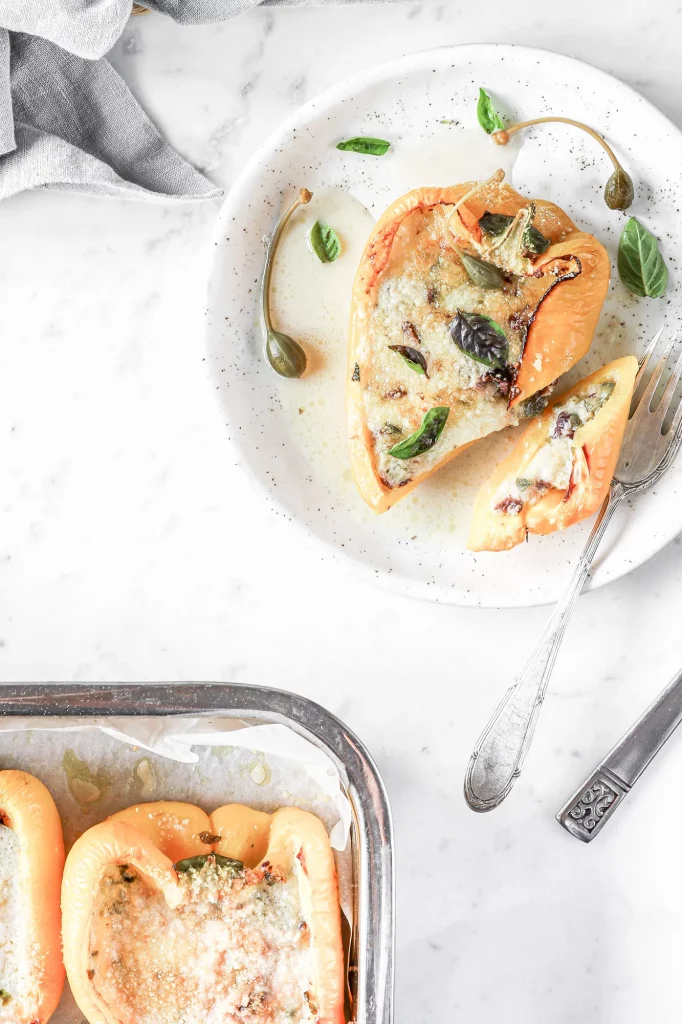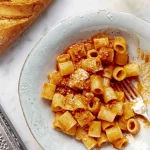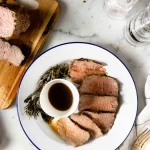Light, absolutely appetizing, fresh, summery, veal in tuna sauce, or “vitel tonnè”, is the classic of the Italian classics, notably from Piedmont.
You will fall in love with this recipe, so I am going to write down every single detail about it, you will be albe to prepare this delicacy on your own.
What do you have to taste it?
Because it is super scrumptious. Your guests will be gobsmacked.
No special dinners can do without this traditional dish which used to be very popular in the past decades. You will take a delicate treasure from the past to your table: your guests will have a second serving. In the 80s, veal in tuna sauce was one of the protagonists of every parties, on special dinners, cocktails, and even in the buffets on cruise ships!
It is still very popular nowadays. Conversely to what is used to be thought, this recipe is not French, but it dates back to the Piedmontese 18th century. Over the years, it has been enriched with mayo and tuna which did not use to be in the first recipe.
It is thought that the genuine recipe didn’t want any tuna, but it took its name because the veal was cooked in the same way as the tuna was. Only later, some tuna ventresche in oil was added to make the dish richer in taste.
Veal in tuna sauce: its history
Why does this ancient recipe contain fish, if Piedmont is not on the coast? The Piedmontese anchovy mongers used to buy salt cheaply in the ports of Liguria (the neighboring region, where Piedmontese still enjoy their seaside holiday, as it is just a couple of hours’ drive), then they put up its price and sold it far more expensively in Piedmont. To avoid customs duties they would hide it under some anchovies which were much cheaper than salt.
Tuna was brought to Piedmont at the end of the 19th century; the Emilian gastronome Pellegrino Artusi first mentioned it in one of his cookery books, “La scienza in cucina e l’arte di mangiar bene” as an essential centerpiece in the Italian food tradition. He suggested using “heifer meat, its thigh or rump cut” to dress with anchovies. Meat was boiled in plenty of water with onion, two cloves, laurel, celery, parsley, and carrot. The broth could be used to cook some delicious risotto. When completely cooled, the meat was thinly sliced and marinated in a sauce made of anchovies, tuna, capers, oil, and lemon for a couple of days.
This is how veal in tuna sauce was born.
This is one of the first genuine Piedmontese dishes I have tasted: actually I have lived in Piedmont for long time, but when I was a child my family used to have typical Emilian habits. My parents would speak the dialect from Ferrara, eat Emilian food, see people from that region. As soon as school finished I was taken to my grandparents to Ferrara where I spent my summer holidays. We often used to go the to neighboring seaside resorts in Romagna.
So, I did not know anything about Piedmont; I have been learning a lot about this region.
And I started from the “vitello tonnato” (when I still wasn’t allergic to fish): it was love at first bite!
It is a toothsome recipe, we have as a starter, but as a nutritionist, it is far more than a starter, it is a complete balanced second course (dressed with some mayo, it gets irresistible).
The cooking time of the meat makes the difference as it must preserve its tender juicy texture, and pinkish color: if overcooked, it gets dark and stringy. Fresh and rich in flavor, veal in tuna sauce can be prepared in advance.
A few tricks for a perfect ‘vitello tonnato’
- Choose only high quality veal meat (nothing else) which must maintain a few essential features when cooked. It must be compact but tender, it mustn’t fall apart when it is cut into thin slices. It must be lean, mayo will make it soft. Opt for the round or the top or bottom sirloin: these cuts may get tough and stringy when cooked, cooled and cut, but mayo makes the meat succulent and juicy;
- Ask your butcher for wrapping a nice piece of meat into a meat net, or tying it to give a round and compact shape;
- For a moist and succulent meat, let it cool down in its broth, so meat may absorb all the juice;
- Slice it carefully: use a long knife with ultra sharp and straight blade; keep away from any knives with serrated edges: the slices must be even and regular. Slice the piece of meat with regular wide movements from the bolster (the part near the handle) to the tip;
More tricks
- Cook the meat as follow (I’ll give you more details later): place the meat (about 1kg for 6-8 people) into a saucepan, add a leaf of laurel, celery, carrot, onion (I also use some rosemary) a glass of wine, a generous pinch of salt, and cover with water. Put the lid on, bring to the boil and simmer for 1 hour and 30 minutes. Turn the heat off and let the meat cool down in its liquid, drain the meat before slicing;
- Do you think it is just a piece of boiled meat? Not at all! You may also cook it in the oven. In Italy, we call it “arrosto morto”, dead roast meat because it is cooked in plenty of water. Brown the meat in a pan with oil, the vegetables and the aromatics, simmer with wine until reduced and then one or two cups of hot broth. Roast in the oven at 180°C (356°F): add more broth if the gravy gets too thick. In this way, the meat won’t turn crispy. It will be tender and juicy, which is perfect to be sliced.
- Make the mayo: that’s where the problem lies! In Piedmont, you can’t buy mayo, you must make it yourself! I usually make it with an immersion blender because it is lighter and fresher than that by hands. Enrich it with tiny pieces of tuna, some anchovies and desalted cappers
Fail proof homemade mayo, choose the right ingredients:
- Choose extra fresh organic untouched eggs;
- Use the whole egg if you make mayo with a stick blender. The proteins of the egg whites stabilize the emulsion.
- All the ingredients must be at room temperature;
- Use an immersion blender or make it by hands with a whisk;
- First run the stick blender and at low speed to combine eggs and oil, then increase at maximum speed when the emulsion gets light and compact.
- Only when mayo is compact, add salt and lemon.
How to fix broken mayo (which has a bad temperament)
First, no panic! Broken mayonnaise is sometimes fixable … not always but you should try before throwing everything away!
The mixture breaks when the ingredients and the tools are too cold or if the oil is poured too fast.
- Use a whisk to fix the mayo: in another bowl, mix 1 tbsp of cold water or white vinegar with three tbsp of broken mayo. Add the other mayo a little at a time and it should become emulsified again;
- If you want to use a food processor: add one egg yolk, pulse intermittently until it gets emulsified again.
All the secrets you have to know to make the perfect Piedmontese vitello tonnato
Ingredients
For the veal
- 0,8-1 kg veal
- 1 carrot
- 1 stick celery
- 1 glove garlic
- 1 medium-big onion
- 2 glasses white wine
- tap water enough to cover the meat
- a bunch aromatic herbs (parsley, rosemary, laurel)
- salt
- 2-3 peppercorns
- 3 tbsp extra virgin olive oil
For the tuna sauce
- 2 medium eggs
- 1 yolk
- olive oil (about 300ml)
- lemon
- salt
- 80 gr tuna tinned in olive oil, drained
- 50 gr desalted capers
- extra 3 anchovies
- extra 3 gherkins
Instructions
For the veal
- Fill a pot with plenty of waters and bring it to a boil;
- If you cover the pot with a lid, water boils faster;
- In the meanwhile wash and clean the vegetables;
- Cut celery and carrot into coarse pieces;
- Half the onion;
- Peel the garlic, but don’t crush it;
- When the water boils, add wine, vegetables, garlic, aromatic herbs, peppercorns, salt, and oil;
- Let the broth boil for about 20 minutes ad then add the meat;
- Remove the foam with a skimmer;
- If you have a kitchen thermometer, make sure the temperature of the meat doesn’t get over 65°C (149°F);
- Simmer for about 1 hour and 30 minutes;
- Let the meat cool down completely in its broth;
- Remove all the meat net or the string;
- Secure the meat with a carving fork, cut it into evenly thin slices with a long sharp straight bladed knife. Use a meat slicer, if you have;
- Place the slices onto a serving dish and cover it with the tuna sauce; garnish with desalted capers;
- Strain the broth and use it for other recipes (you may also freeze into single servings container, or into an ice mould tray)
For the tuna sauce
- Prepare the sauce the day before;
- Put the eggs and the yolk into the immersion blender cup;
- First run the immersion blender and at low speed to combine eggs and oil, then increase at maximum speed when the emulsion starts to get compact;
- With the immersion blend running, add oil until the mixture gets thicker (you can feel it from the blade movement);
- Season with salt and the freshly squeezed juice of half a lemon;
- Finely chop tuna, capers and the extra ingredients to your taste;
- Combine the tuna mix with the mayo until a smooth and even sauce;
- Let sit the sauce in the fridge overnight then spread it onto the sliced veal; garnish with a few whole cappers.
- Don’t use tuna or anchovies, if you are allergic to fish as I am; just capers and gherkins!
Notes
- Long simmering can make the meat dark and tough. You may cook it for shorter time (but not less than 1 hour) for a pinkish and more tender texture.
- For a pinkish meat, roast it in the oven. Brown the meat in a pan with oil, the vegetables and the aromatics, simmer with wine until reduced and then a a cup od two of hot broth. Roast in the oven at 180°C (356°F): add more broth if the gravy gets too thick. Drain the meat from the cooking liquid and let it cool down on an aluminium foil;
- If you are short in time, use a steel pressure cooker. Brown the meat in a little oil, simmer with white wine and add vegetables and aromatic herbs; sautés for a few minutes and pour a glass of lukewarm warm. Lock the lid, bring to pressure and cook over medium-low heat for about 50 minutes.
- If you can’t find the right veal cut, you may also prepare pork loin in tuna sauce. The method is the same: boil the meat in plenty of water with vegetables and aromatic herbs; when completely cold, slice and dressed it with the gorgeous tuna sauce.
How can you store veal in tuna sauce?
Cover veal in tuna sauce with cling film, and store it up to 1 or 2 days in the fridge. Yon can’t freeze it, but I think you and your family will eat this delicacy in a few days easily! It also fits a fast and satisfying lunch break, or a toothsome sandwich.
Tuna sauce can be stored in the fridge in an airtight container up to 2 or 3 days.







Like!! Great article post.Really thank you! Really Cool.
many thanks! lovely words ☺️